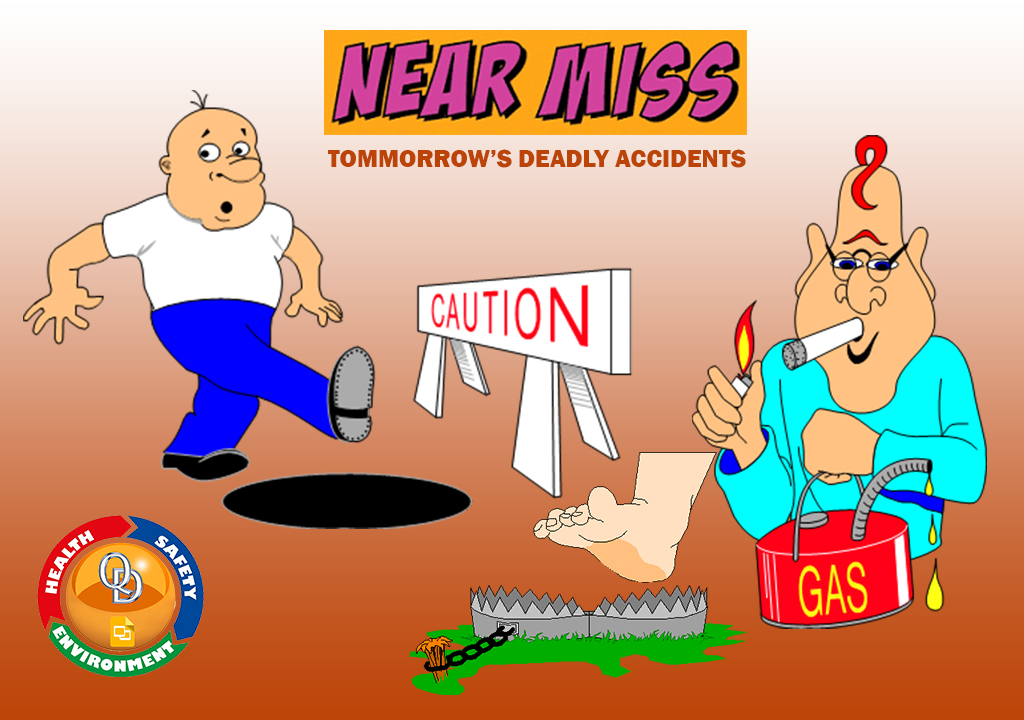NO INJURY-NO INCIDENT?
“Near Misses”
Accident Ratio Study
- Serious Incident-Includes recordable and disabling Injuries
- minor injuries-Any reported injury less than recordable
- Property Damage & Incidents-All Types, including environmental releases
- Incidents with no visible-Injury or Damage
- (Critical Incidents – Near Misses)
Accident Causes
A. Unsafe Act – 88%
An act with the aid of the injured person or every other character (or both) which brought on the accident; and/or
B. Unsafe Condition – 12%
Some environmental or hazardous situations which caused the accident are independent of the employee(s)
Why Minor Incidents Go Unreported
Fear Of:
- Supervisor/Manager Disapproval
- Getting a Bad Reputation
- Being terminated or disciplined
Not Wanting To:
- Lose time from the job
- Risk Embarrassment, Peer Pressure
- Have an incident on their work record
- Be the subject of or get involved in an investigation process
- Not knowing why minor incidents should be reported or what near misses are.
WHY THE RELUCTANCE TO REPORT?
- It’s usually inconvenient to fill out the “accident form”.
- Near miss experiences are “private affairs”.
- “Organizational Influences”- What’s to be gained? A pleasant or unpleasant experience.
- Slogans like “All injuries are preventable” don’t help.
- Offering rewards for reporting near misses don’t help.
A DIFFERENT FOCUS!
- Environmental Assessments
- Particularly Property Damage
- We need to investigate property damage where there is no injury.
- If damaged equipment or physical structures are not repaired, injuries will eventually follow. Yet little
- value is given to investigating property damage.
- Property Damage is a physical trace of an incident.
Why Focus on Near Misses?
- Establish Causes
- To Prevent Recurrences before they happen and become Recordable or Serious
- Establish corrective actions
- Learn from the incident
- Improve our company’s safety culture
- Statistical safety database
What is a Near Miss Accident?
- “Near miss” are events which are unexpected occurrences that just missed being an employee or equipment incident or an environmental release.
- One step away from an employee or equipment incident or an environmental release
- Any deviation beyond the safe operating limits of process parameters or procedures.
- Challenge the last line of defence.
- Failure of any one or multiple safeguards.
Near Miss Examples
- Operating heavy equipment too close to each other almost collides due to operating activities being close in proximity.
- Equipment is not tied down properly on the truck bed; equipment is loose, or it falls off without striking anything or anyone.
- Waterblast operators blasting too close to each other without striking each other but could potentially have.
- Backing up in a forklift without looking back and another employee passes behind without the operator aware.
- Not cleaning up a spill and someone else finding it and cleaning it up.
- A truck arrives to be unloaded, during travel the load has shifted when the door is opened a drum falls out just missing an employee.
- Kicking a brace and almost fell.
- Climbing out of Bob Cat and foot slipped on the step.
- Slightly damaged van, pulling the trailer out of the dock.
- Sprayed with solvent after opening 55-gallon drum.
- The pallet broke, spilling chemicals, and the weather deteriorated the pallet.
- Sprayed with etching after pressure build-up in line.
- Pressure in a tank caused the material to shoot out the probe inlet.
- Stepped into the open sump when unloading the oil tanker.
- Chemical splash, after pressure build-up at filter basket.
- Guard rail broke when the employee was climbing down. While excavating an area, a gas line was struck and broken, releasing natural gas. The owner assured us before work that all lines were blocked and/or locked.
- An employee reached into a piece of moving equipment without shutting it down to dislodge a jam, no injury or equipment damage occurred…. This time. (Shut down equipment and lockout/Tagout)
- A major release of flammable gas that forms a vapour cloud but does not explode.
- A major release of hazardous material into a storm sewer that is successfully impounded before the material enters a waterway.
Investigate?
- Near-Miss incidents, like no-injury accidents, must be investigated whenever reported or observed.
- They are forewarnings of what can and might happen.
- An accident is almost always sure to follow when such forewarnings are ignored.
- Need to Complete a Whole Incident Investigation?
- Have a separate, simple Near Miss Report Form.
- The activities from the Near Miss Report can be used to expose traits in protection overall performance along with the Risk Ranking.
- Can be used to reveal tendencies in safety performance together with the Risk Ranking.
- When the trend or risk ranking changes, increasing the likelihood, full incident investigations may be needed to determine the cause of the change for a particular incident cause or risk.
Extra Effort Needed
- We sometimes question near miss incidents, but the causes of today’s near miss incident, if not determined and corrected, may occur again to produce tomorrow’s employee or equipment incident or an environmental release.
- Accident investigations must be directed not only at what did occur but also at the potential of what could have occurred.
“INVESTIGATE ALL NEAR MISS INCIDENTS”!
Nothing is found out from unreported incidents and the reasons are left uncorrected!
Always Encourage YOUR WORKERS to Report Near Miss Incidents by:
- Make sure that all employees are inducted and advised to report near-miss incidents.
- Positively reinforcing each other when reporting near-miss incidents.
- Reminding ourselves of its importance.
- Sharing successes–improved work environment across the entire company.
- Using the incident investigation’s Safety form for the investigation and reporting document.
- Having the forms readily available to all employees.
